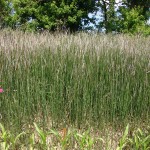Wheat harvest started last week and will be wide open this week of May 21st. Double-crop soybean planting will begin in earnest. Continue reading
Category Archives: Wheat
Crop Progress
As reported by NASS on May 14, 2012
WEEKEND SHOWERS WELCOMED BY FARMERS
Showers and thunderstorms provided some needed relief this weekend, but it has been so dry recently that all regions of the state continue to need a general soaking rain. Crops continue to develop at rapid rate well ahead of normal. Corn planting is complete, all emerged and in mostly good condition. Cotton and soybean planting and tobacco transplanting were the main farm activities last week. Fertilizing, spraying post-emergence herbicides and hay harvest were also major farm activities. The wheat crop is ripening and farmers expect to begin harvest within the next two weeks. Continue reading

Controlling Scouring Rush In and Around Crop Areas

Over the past several years many have had concerns about scouring rush creeping into crop production areas. Scouring rush is not a typical agronomic weed. It normally grows along fence rows, ditch banks, and low lying areas. However, in long term no-tillage production systems scouring rush is increasingly encroaching into crop production areas.
Crop Progress
As reported by NASS on May 7, 2012
SCATTERED SHOWERS PROVIDE LITTLE RELIEF
Unusually high temperatures and sunny days combined to minimize the benefits of scattered showers that fell in many areas across the state. Reporters in all regions reiterated the need for a general soaking rain. Row crops were holding on with three-fourths of the corn and winter wheat acres rated in good-to-excellent condition. Crop development continues to advance well ahead of the normal pace. Pastures declined some from the previous week, but cattle were reported to be mostly good condition. Other farm activities this week included post-emergence herbicide and fertilizer applications, cutting hay, scouting for insects and diseases, harvesting strawberries, and continued assessment of freeze damage on fruit crops. Continue reading
Bugs of the Week
Overall, I’m not getting any reports of widespread problems in any crop, but there has been a smattering of several things including … Continue reading
Crop Progress
As reported by NASS on April 30, 2012
A GOOD GENERAL SOAKING RAIN NEEDED!
Rainfall totals throughout most of the state last week were below normal, which led to short-to-very short soil moisture supplies in almost forty percent of the farmland. All crops and pastures, however, remain rated in mostly good-to-excellent condition with development advancing well ahead of the normal pace. Continue reading
Armyworm Action in Wheat is Picking Up
I’ve had calls about cutworms and slugs this week. You can see my comments about slugs in last week’s post (link here). However, the most common question has been on armyworms in wheat. Calls have varied from low populations, but some with head clipping, to high populations that have caused severe defoliation. The picture below is that of near complete defoliation, including the beards of wheat, from Crockett County. Continue reading
Crop Progress
As reported by NASS on April 17, 2012
FIELDWORK AND CROP DEVELOPMENT AT RECORD PROGRESS LEVELS. Corn planting continued at a blistering pace last week and early hay and strawberry harvests began. The wheat crop was in the heading stage. These development events at week’s end were at a record rate that is a full three weeks ahead of the five-year average tempo. Many corn growers reported that they were completely finished planting. Tennessee’s wheat crop and pastures continued in good-to-excellent condition. Continue reading

